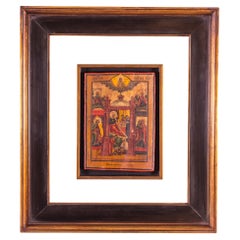17th Century Russian Icon
Antique 17th Century Russian Wall-mounted Sculptures
Gold Leaf
1990s Byzantine Mixed Media
Gold Leaf
Antique 17th Century Russian Baroque Wall-mounted Sculptures
Gold Leaf
Antique 17th Century Russian Religious Items
Wood
Antique Late 17th Century Russian Religious Items
Wood
Late 17th Century Other Art Style Figurative Paintings
Tempera
Antique Late 17th Century Russian Gothic Religious Items
Silver
Antique 17th Century Russian Renaissance Paintings
Wood
Antique 16th Century European Other Religious Items
Wood
17th Century Russian Icon For Sale on 1stDibs
How Much is a 17th Century Russian Icon?
Hunt Slonem for sale on 1stDibs
Hunt Slonem has mastered the art of repetition in his exuberant Neo-Expressionist paintings. Some of his favorite subjects are bunnies, butterflies and the tropical birds that live in the private aviary nestled within his 30,000-square-foot studio complex in Brooklyn, New York.
“I believe in repetition like a holy mantra or rosary,” Slonem told Introspective, referring to his artistic method. “I am slightly influenced by Pop art, like the repetition of soup cans, postage stamps and celebrities. It’s something I have been doing my whole life.”
Slonem’s depictions of birds — which are often rendered in thick, gestural brushstrokes and arranged in a loose grid — owe to a fascination with tropical avian life that he developed during a childhood spent in Hawaii and Nicaragua. Today, along with the aviary, his studio contains a personal garden, a collection of antiques and walls and walls of artworks.
“I am a collector of things. My primary focus is color and objects. I love to make them work in a space,” Slonem says. “Sometimes I define a space with color.”
Besides birds, Slonem has painted so many bunnies that they’ve become a signature. Limned in expressive, urgent strokes on flat, vibrantly colored backgrounds, these creatures fascinate through their subtle variations. “I have painted hundreds of rabbits, but each one is different,” the artist has explained. “Each has its own personality, and it just comes through me.”
The multitalented Slonem also sculpts, makes prints, creates installations and restores historic spaces. His work has achieved cult status among collectors and is represented in the permanent collections of such esteemed institutions as the Metropolitan Museum of Art. Slonem has even made an appearance on Real Housewives of New York.
Find original Hunt Slonem paintings, prints and other art for sale on 1stDibs.
Finding the Right Abstract-paintings for You
Bring audacious experiments with color and textures to your living room, dining room or home office. Abstract paintings, large or small, will stand out in your space, encouraging conversation and introducing a museum-like atmosphere that’s welcoming and conducive to creating memorable gatherings.
Abstract art has origins in 19th-century Europe, but it came into its own as a significant movement during the 20th century. Early practitioners of abstraction included Wassily Kandinsky, although painters were exploring nonfigurative art prior to the influential Russian artist’s efforts, which were inspired by music and religion. Abstract painters endeavored to create works that didn’t focus on the outside world’s conventional subjects, and even when artists depicted realistic subjects, they worked in an abstract mode to do so.
In 1940s-era New York City, a group of painters working in the abstract mode created radical work that looked to European avant-garde artists as well as to the art of ancient cultures, prioritizing improvisation, immediacy and direct personal expression. While they were never formally affiliated with one another, we know them today as Abstract Expressionists.
The male contingent of the Abstract Expressionists, which includes Jackson Pollock, Willem de Kooning and Robert Motherwell, is frequently cited in discussing leading figures of this internationally influential postwar art movement. However, the women of Abstract Expressionism, such as Helen Frankenthaler, Lee Krasner, Joan Mitchell and others, were equally involved in the art world of the time. Sexism, family obligations and societal pressures contributed to a long history of their being overlooked, but the female Abstract Expressionists experimented vigorously, developed their own style and produced significant bodies of work.
Draw your guests into abstract oil paintings across different eras and countries of origin. On 1stDibs, you’ll find an expansive range of abstract paintings along with a guide on how to arrange your wonderful new wall art.
If you’re working with a small living space, a colorful, oversize work can create depth in a given room, but there isn’t any need to overwhelm your interior with a sprawling pièce de résistance. Colorful abstractions of any size can pop against a white wall in your living room, but if you’re working with a colored backdrop, you may wish to stick to colors that complement the decor that is already in the space. Alternatively, let your painting make a statement on its own, regardless of its surroundings, or group it, gallery-style, with other works.
